And does the rule of thirds really matter?
Raptor takeoff and flight shots are prized by many bird photographers, including yours truly, but waiting for birds to launch can seem to take forever. As a result, keeping them in the viewfinder and in focus prior to takeoff and maintaining a hair trigger on the shutter button for extended periods of time is tense and mind-numbing business. I sometimes sit on raptors for 20 minutes or more while I’m waiting for takeoff and when it’s over, win or lose, I feel like I’ve been through the ringer.
Eventually the intensely-concentrating photographer needs a break, if only for two or three seconds, but the nanosecond you look away is when the bird will invariably take off so you miss the shots.
But thankfully, large raptors in particular often telegraph their intention for imminent takeoff, which allows the knowledgeable photographer to regain concentration and make it much less likely to miss the takeoff shots. All you have to do is recognize the behaviors and take advantage of them.
A raptor at rest will often perform one or more of the following behaviors just prior to taking off.
- poop (possibly a weight-saving device)
- wing-stretch (stretches flight muscles prior to use)
- turn into the breeze or wind (makes takeoff easier, so it requires less energy)
- rouse (shaking to reorganize out of place feathers, which makes flight more efficient)
Today I’ll concentrate on the fourth behavior – rousing.
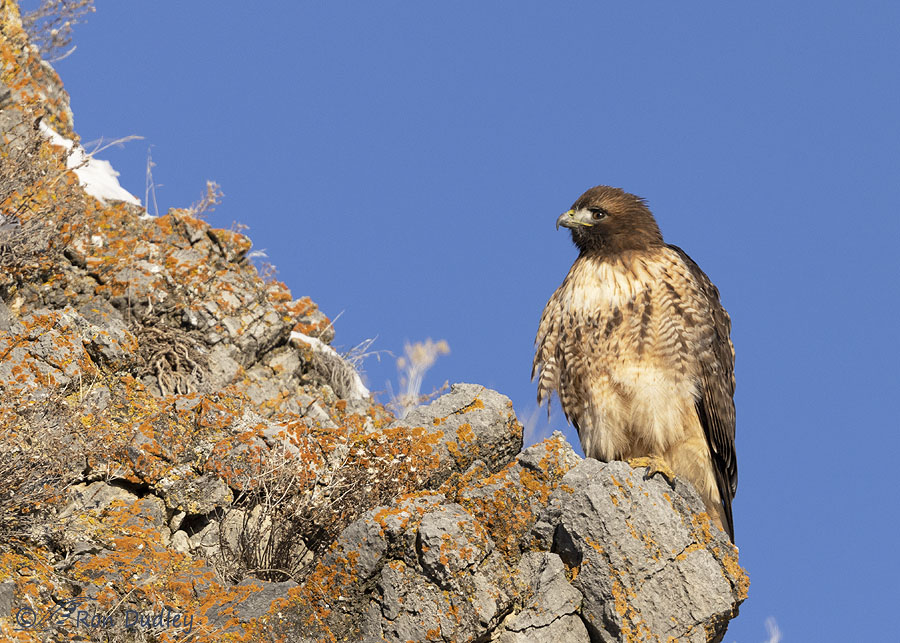
1/3200, f/5.6, ISO 500, Canon R5, Canon EF500mm f/4L IS II USM + 1.4 tc, not baited, set up or called in
Five days ago I waited a long time for this presumed female adult Red-tailed Hawk to take off but even though I was close to her she seemed perfectly content where she was. Every two or three minutes I had to give my brain and my strained right eye (my “shooting eye”) a quick break so I’d momentarily look away by re-checking my camera settings or looking at the bird with my naked eye or just closing my eyes for a second or two.
I was just lucky that she didn’t choose one of those times to take off. They seem to take great delight in doing so.
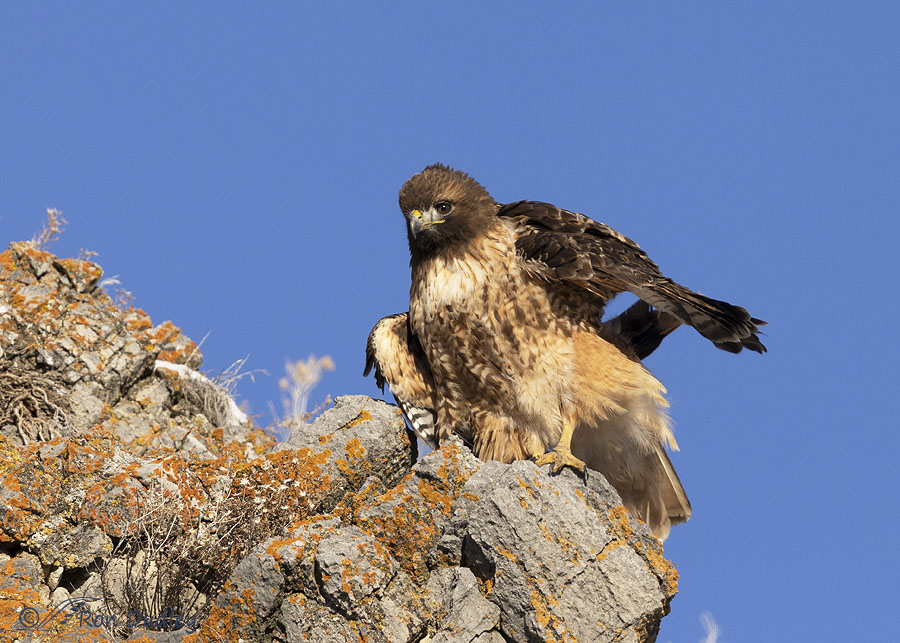
1/4000, f/5.6, ISO 500, Canon R5, Canon EF500mm f/4L IS II USM + 1.4 tc, not baited, set up or called in
But suddenly she roused, which told me that she was likely preparing to take off momentarily so I focused my concentration on her intensely again.
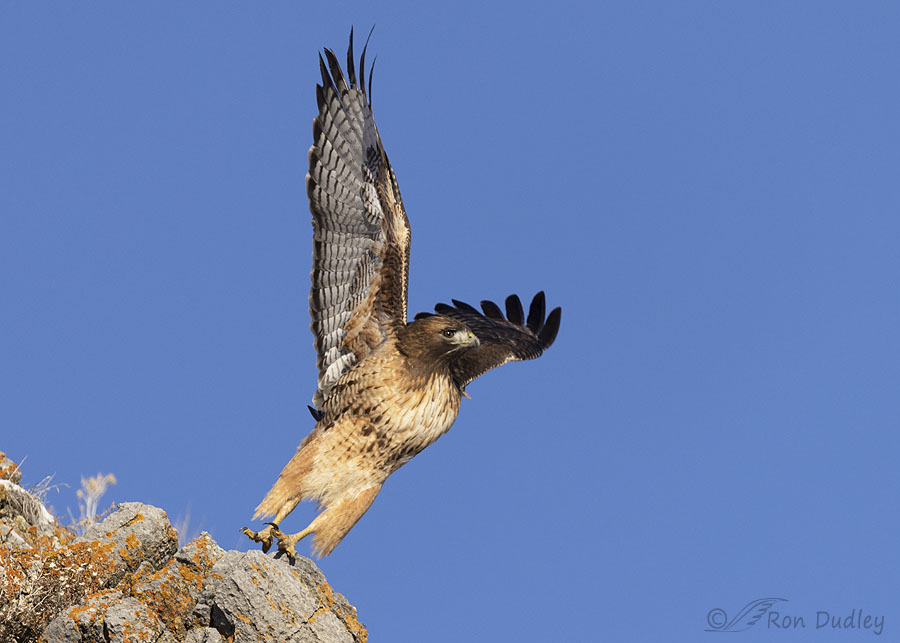
1/3200, f/5.6, ISO 500, Canon R5, Canon EF500mm f/4L IS II USM + 1.4 tc, not baited, set up or called in
And a few seconds later that’s exactly what happened. I got the takeoff and flight shots because I was prepared for them – thanks to her rouse. Raptors don’t always rouse prior to takeoff but when they do it’s very helpful to the savvy photographer.
There may be several seconds or up to a minute or so between rouse and takeoff (if it happens at all) but occasionally rouse and takeoff happen simultaneously. So when they begin to rouse you have to re-gain your concentration very quickly.
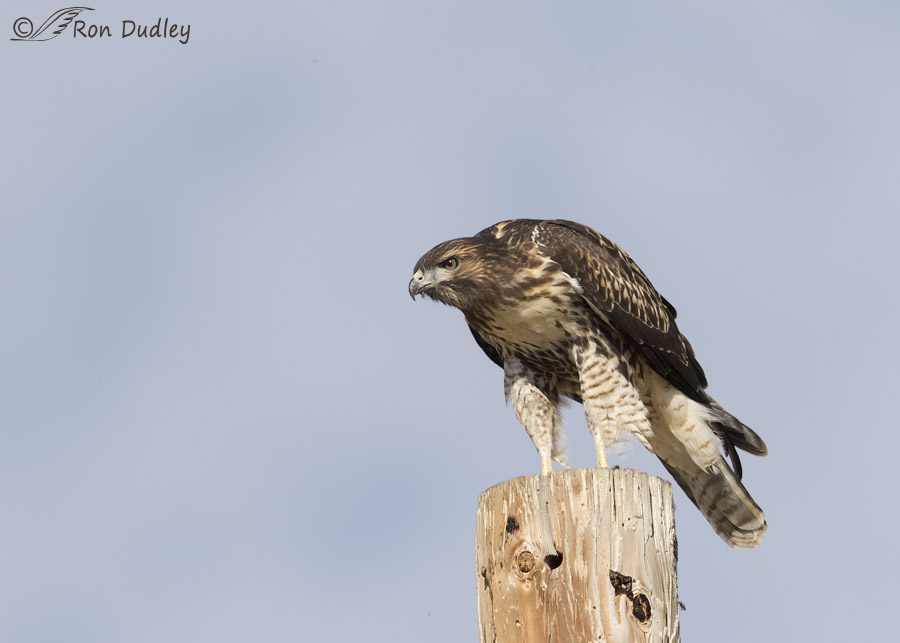
This grumpy-looking immature Red-tailed Hawk began to…
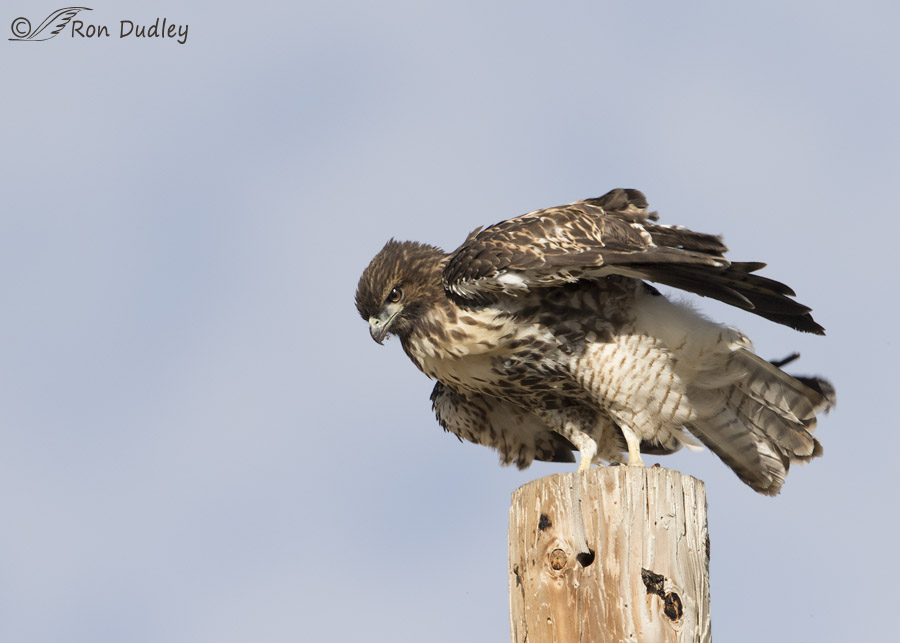
rouse and during the middle of it ‘he’…
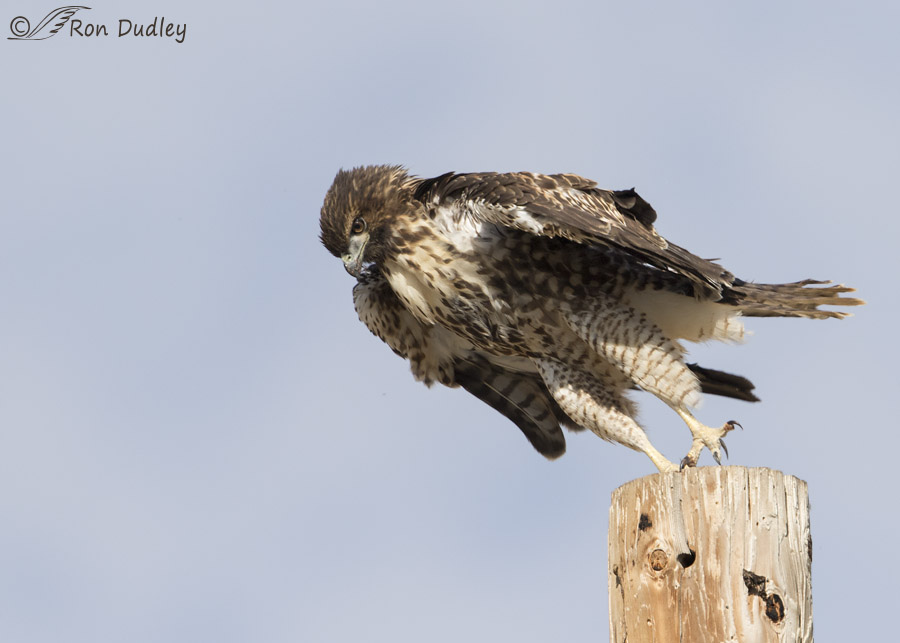
took off, which surprised the hell out of me. I was just lucky that I’d gained my concentration as quickly as I did.
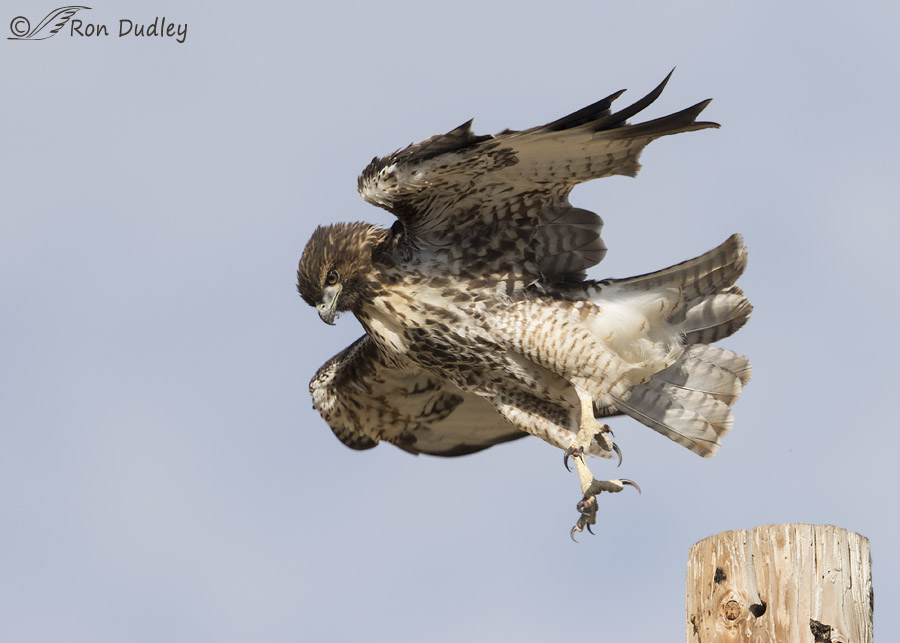
He continued to rouse in flight for…
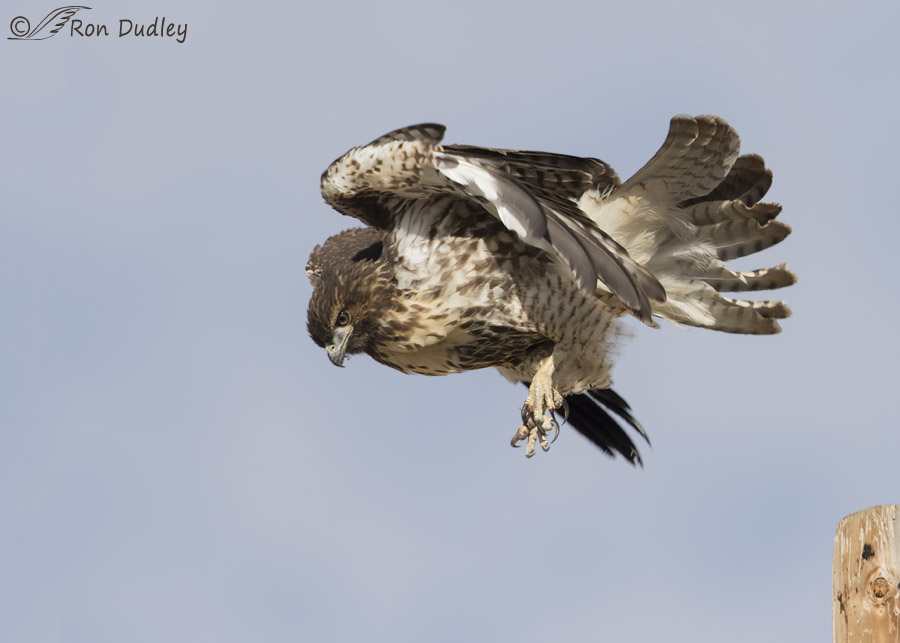
several more photos in the burst. I’ve seen this happen a few times but usually I wasn’t expecting the bird to take off in the middle of the rouse so I didn’t gain my concentration quickly enough and missed the takeoff.
Takeoff shots are easy to miss, even with larger and slower raptors, so photographers need every edge we can get. It helps a lot to be able to recognize and read behaviors.
Ron
On an unrelated note:
Like many photographers, and perhaps most bird photographers, I’m fully aware of the “rule of thirds” when it comes to composition but when I’m in the field that rule typically gets left by the wayside. As active and uncooperative as birds are, I’m often lucky just to get them in frame so I don’t think much about compositional rules when I’m taking photos. My philosophy that rules are meant to be broken gives me solace. And an excuse.
But when I was cropping the first photo above I achieved something that rarely happens with my photos.

By placing the hawk’s eye in the frame where I did I satisfied the rule of thirds exactly and still liked the composition.
With me that doesn’t happen very often. I’m not sure it accomplished anything positive, but I did sit up and take notice.


You’ve had some pretty cool “pre-flight offloading” shots over the years, Ron. 😉
Really like these shots. It blows me away when a bird takes off mid-rouse and keeps rousing (or preening) in early flight. I’ve seen it with water birds often, and I always marvel at this level of multitasking.
Thanks, Marty. I hadn’t thought of what you said about “water birds” but you’re absolutely right.
In retrospect, the Cooper’s hawks who dine on our backyard birds tick off all the items on your pre-takeoff list. Their favorite dining area is a low spruce branch near my kitchen window, and after about an hour of watching the whole meal process (eating 1/2 hour, resting 1/2 hour, and the binocs are getting really heavy!), it’s almost a relief to see the poop, the stretch, the turn, the shake, the takeoff. So I’ve seen it, but never knew it was a predictable set of behaviors. Thanks for the lesson!
And thanks for the series of young goofball hawk – kind of like the sleepy kitten who falls off the sofa – “No, really, I meant to do that!”
Hope your snow falls deeply on Great Salt Lake and not so much on your driveway!
Thanks, Carolyn. We’ve had near-record snowfall in our mountains this winter which will certainly help with the lake. It’s already come up over a foot since November and that’s before spring snow melt.
As much as I love your beautiful female in the first set of photos (and appreciate your “accidental” adherence to the rule of thirds), I have to admit I’m very enamored of “Grumpy Hawk” — who perhaps is still to immature to know he shouldn’t have launched before completing his rouse! 😉
Oops! TOO immature … wow, this is what happens when you oversleep! 🥴
I’m fond of him too, Chris – because of both his grumpiness and his in-flight rouse.
A major part of what makes studying birds so rewarding is learning and beginning to understand their behaviors. Great series.
You’re right about that, Dan. Thanks.
LOVE every photo in your post today Ron! (You know I love your hawks!) And thank you for sharing a moment in the bird photographer’s life. So interesting!
Good. Thank you, Kathleen.
Rules are meant to be broken – by birds as well as photographers. And of course they take off in the millisecond you have relaxed. That is rule that they rarely break.
“That is rule that they rarely break.”
You’re right, EC. Birds. Birds are much better at not breaking that rule than I am at not breaking the rule of thirds.
That third photo reminds me of a gymnast or diver. Love this series.
Thanks, Arwen.
Reading the title for this post I thought it was going to be about you getting up in the morning.
Lots of unusual and somewhat comical postures. The second photo reminds me of a center about to hike the ball to the quarterback.
I thought I recognized that little yellow plant to the left of the Hawk from the 8º day.
I almost never consider composition. I’m just glad to get whatever in the frame and in focus. I’m impressed though that you nailed the rule of thirds in the photo.
“I thought I recognized that little yellow plant to the left of the Hawk from the 8º day.”
Yup, it’s the same day, Lyle. That photo was taken right after the third photo above.
Rousing and hackles on my dog and look at all the eye catches you captured….means you have sun-please send some sun to Illinois….Thank you for your eyes also!
Diane, these first photos were taken 5 days ago and the others several years ago. There’s no sun around here now and hasn’t been for a while. We’re forecast for snow for the next three days.
Really excellent images. Patience paying off!
Thank you, Bruce.
I like the way you think. You are open minded and that opens many doors.
Take Care,
Kaye
“You are open minded”
Kaye, I try to be but I don’t always succeed.
Such a practical and helpful post!! Thank you!
Thanks, Kellie.
As they say, “Rules are meant to be broken.” Have often broken the rules with really good results. That second set was surprising taking off like that while rousing. You don’t see that often. Sometimes you can wait forever for a takeoff. With eagles I have sometimes given up because it has gone past 30 minutes and my shoulders ache. Of course as soon as you leave you can count on a take off. Good educational series.
“Of course as soon as you leave you can count on a take off”
Or even before you leave, Everett. All you have to do is take your eye off them and they take off.
Love the series of shots you got on that immature RT. I’m sure I’ve seen this before, but your closeup photos reveal the curious details of this rouse-n-takeoff combo that ordinary observation would not see. Have to note, the third photo of that series strikes me as comical. But there is an intensity and purposefulness in his gaze. Did it dive down on something afterward?
“Did it dive down on something afterward?”
As I recall, he didn’t Michael. He just vamoosed.
Great photographs, as expected, but also a good tutorial on how to attempt better take-off shots for raptors. In my case, “attempt” being the key word.
I’ll keep practicing.
Happy to know I am not the only rule-breaker around here.
Thank you, Wally. When I was a kid my mother used to say that it’s in my nature to break rules. “Always testing, aren’t you Ronnie!”
Wow! I too watch for “rousing” though I didn’t know the term until now but I don’t have your patience or perseverance or as many raptors within reach so I am very happy that you like to share your experiences. I’d be happy to have any of these, except for the first, grace my wall so yeah, the rule of thirds may be over-rated.
Thanks, Granny Pat. No rule, including that one, can make a poor photo into a good one.
1st hawk is gorgeous and the stretch of take off magnificent! The 2nd hawk is almost a giggle – he’s SUCH a mess rousing as he took off and during flight! 🙂 Rule of thirds – welllllll when it comes to birds……. 😉
Warm and windy ahead to toe storm and sub-zero temps the next day or so – February in North Central Montana on it’s way – UGH!
“he’s SUCH a mess”
He is, isn’t he Judy. Makes me laugh every time I see those photos.
We’re supposed to have snow for the next 3 days in a row. That stuff is really building up in our mountains!
Snow build up is good news! Our area not so much – hoping it hops to it the next couple of months……